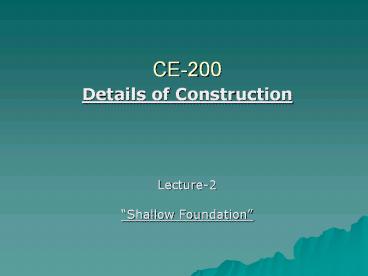CE-200 - PowerPoint PPT Presentation
1 / 24
Title: CE-200
1
CE-200
- Details of Construction
- Lecture-2
- Shallow Foundation
2
(No Transcript)
3
Definition
- A foundation is a structure that transfers loads
to the ground. Foundations are generally broken
into two categories - shallow foundation
- deep foundation
4
- A shallow foundation is a type of foundation
which transfers building loads to the earth very
near the surface, rather than to a subsurface
layer or a range of depths as does a deep
foundation. - Deep foundations are used to transfer a load from
a structure through an upper weak layer of soil
to a stronger deeper layer of soil. Deep
foundations are distinguished from shallow
foundations by the depth they are embedded into
the ground.
5
Foundation Depth
- foundation design depends on various factors,
e.g. type of building, type of construction/materi
als used, ground conditions, site slope, natural
hazards etc. - designer/engineer will consider these factors
when determining the design of a buildings
foundation.
6
Objectives of Foundation
- To distribute the load of the structure on large
area. - To distribute the load on underlying soil evenly.
- To provide a levelled and hard surface for the
super-structure to be built over it. - To increase the stability as a whole against
sliding, overturning or other distribution forces
like wind, rain etc. - To prevent lateral movement of the supporting
materials so that safety of the structure is not
endangered.
7
Types of Shallow Foundation
- Spread footings
- Grillage footings
- Eccentrically loaded footings
- Combined footings
- Mat or raft foundation
- Spread footing is further classified as
- Wall footings
- Reinforced concrete footings
- Inverted arch footings
- Column footings
8
Different footings
9
- Wall foundation
- Reinforced Cement Concrete (R.C.C.) foundation
- Inverted Arch footing
- Column footing
10
Grillage Foundation
- A network or frame of timber or steel serving as
a foundation, usually on ground that is wet or
soft. - A framework of heavy timbers, steel, or
reinforced concrete beams laid longitudinally and
crossed by similar members laid upon them to
spread a heavy load over a larger area, esp. for
use where the ground is not firm.
11
Grillage Foundation
- A series of steel beams, bolted together and
placed over a footing used to distribute a
concentrated column load over the top of the
footing.
12
RAFT FOUNDATION
- Raft foundation are required on soil of low
bearing capacity, or where structural column or
other loads areas are so close in both direction
that individual pad will nearly touch each other.
The function of raft foundation are to spread the
load over as wide an area as possible, and to
give a measure of rigidity to the sub-structure
to enable it to bridge over local areas of weaker
or more compressible soil. The degree of rigidity
given to the raft also reduces differential
settlement. It is useful in reducing different
settlement on variable soils or there is a wide
variation in loading and adjacent column or other
applied loads.
13
- Typical use
- Rafts are used to bridge over soft spots if the
spots are very localized and to reduce the
average pressure applied to the soil. Raft
foundation can be used as a matter of
constructional convenience in structure supported
by a grid of fairly closed spaced columns. - In such case, an overall raft will avoid
obstruction of the site by a number of a
individual excavation with their associated heaps
of spoil.
14
- Some designer work on the rule that if more than
50 of the area of the structure is occupied by
individual strip foundation it will be more
economical. - Normally built at for support construction at low
bearing capacity such as abandon at the slopping
site which are refilled or not.
15
- Where constructed
- In made-up ground
- Soft clay
- Marshy areas
- Uncertain behavior of subsoil water condition
- Pile foundation cannot be used advantageously.
- Independent column footing is impracticable.
16
Raft Foundation
17
Raft with piles (pile cap)
18
Combined Footing
- This type of footing is provided under the
following circumstances - When columns are very near to each other and
their individual footings overlap. - When bearing capacity of the soil is less,
requiring more area under individual footing. - When the end column is located at or near the
property line and its footing can not be extended
on the side of the property line.
19
(No Transcript)
20
(No Transcript)
21
Eccentrically loaded foundation
- The foundation (wall or column) should be so
shaped and proportional that the c.g. of the
imposed loads coincide with the c.g. of the
supporting area of base. Thus, the distribution
of pressure on the soil remains uniform.
22
- Eccentrically loaded foundation has got two
categories - Offsetting the footings
- By providing strap footing
23
Conclusion
- Buildings are built for a purpose schools for
education, offices for work, theatres for
culture. Each building is a blend of form and
function - to be aesthetically pleasing as well
as to fulfill the purpose for which it was
created.
24
Conclusion
- Foundations do not typically contribute to the
architectural aesthetics of a building. Yet,
without suitable foundations, a building will not
function effectively, will be unsafe and its
architectural merits will rapidly fade.

